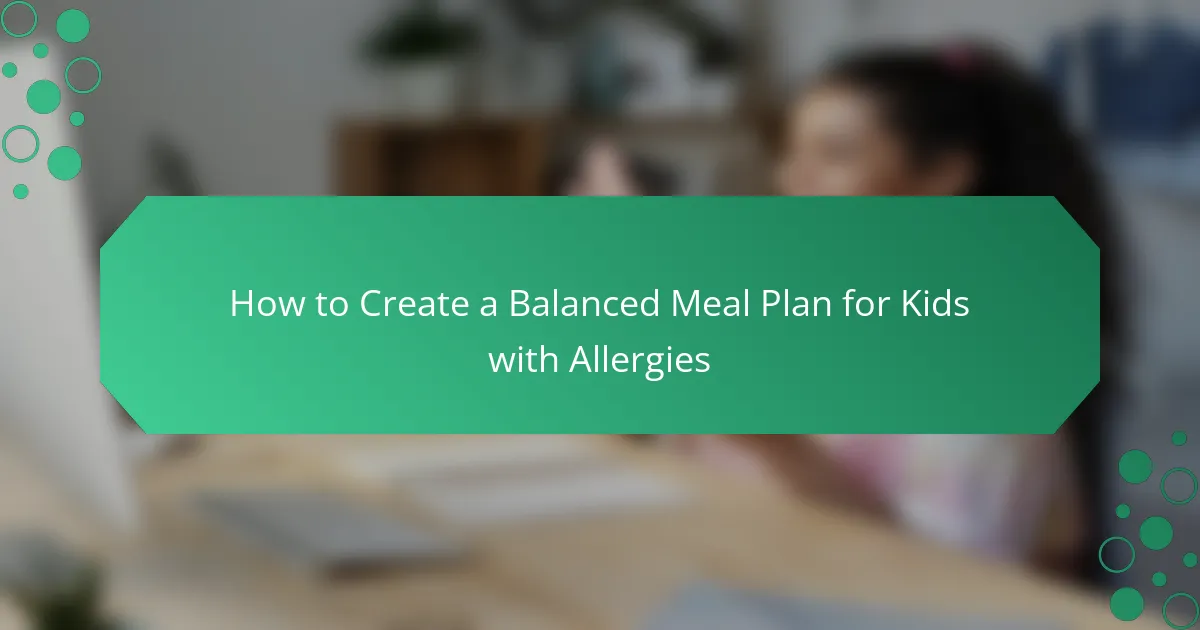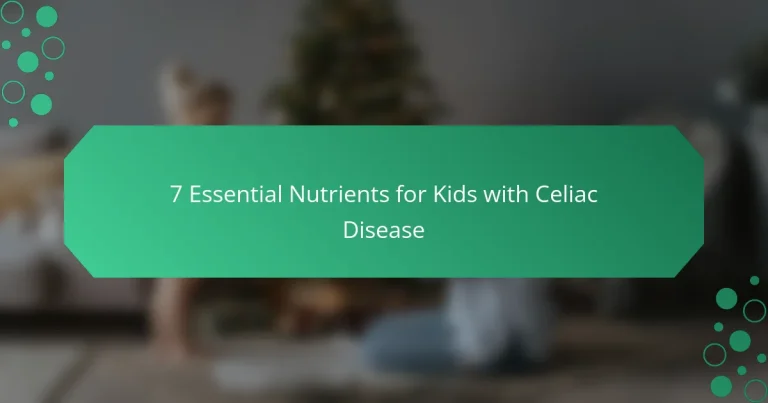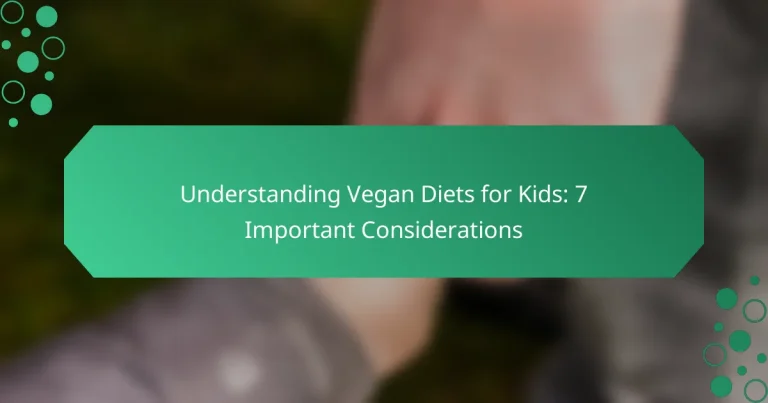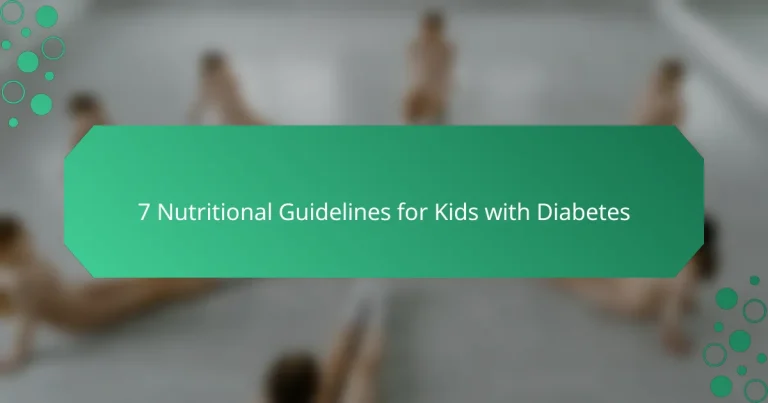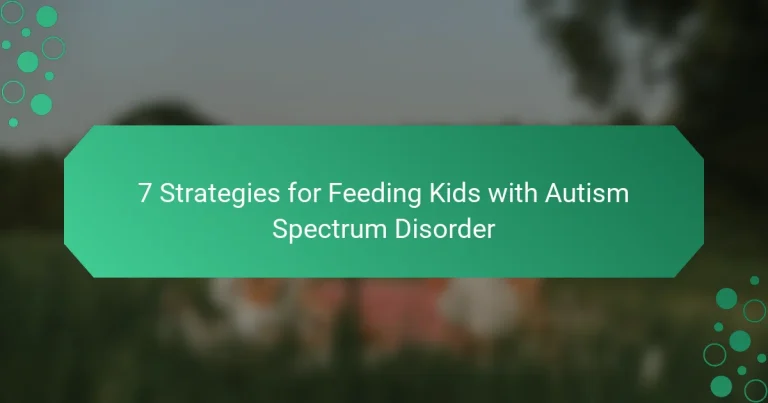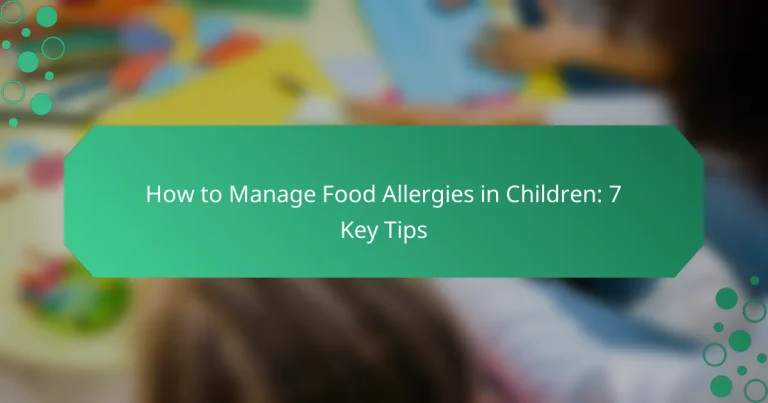How to Create a Balanced Meal Plan for Kids with Allergies
Creating a balanced meal plan for kids with allergies is essential for their health and development, ensuring they receive vital nutrients while avoiding allergens. Incorporating a variety of fruits, vegetables, proteins, grains, dairy alternatives, and healthy fats can help achieve this balance. Practical meal planning strategies can further enhance nutrition and safety, making healthy eating both enjoyable and manageable for children.
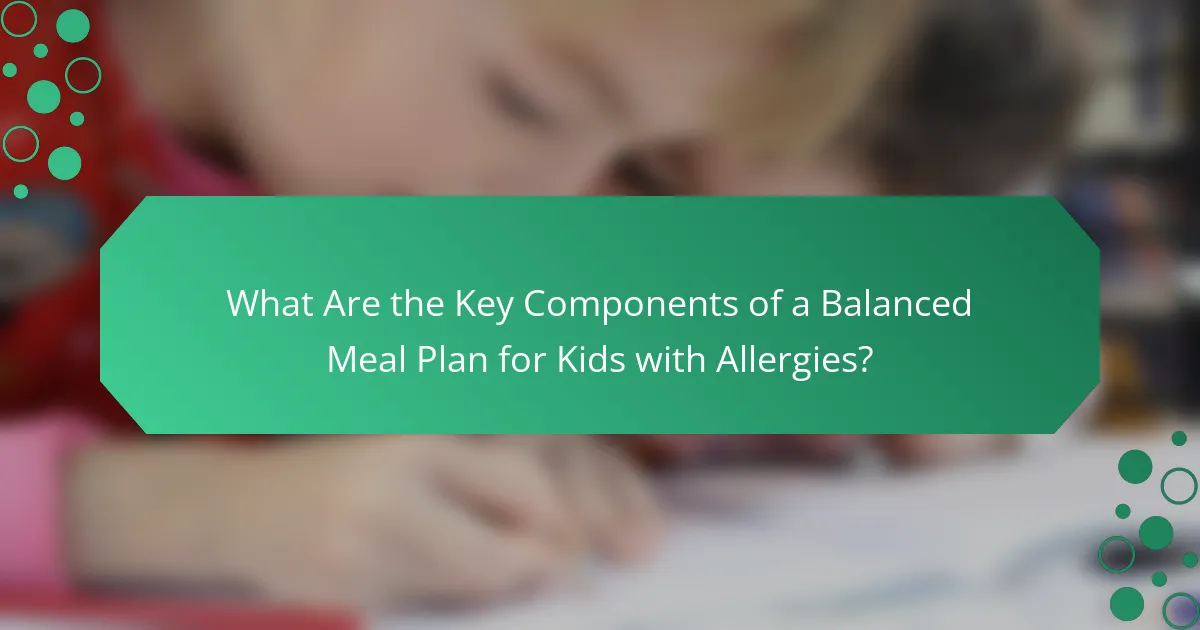
What Are the Key Components of a Balanced Meal Plan for Kids with Allergies?
A balanced meal plan for kids with allergies includes a variety of foods that provide essential nutrients while avoiding allergens. Key components include fruits and vegetables, proteins, grains, dairy alternatives, and healthy fats, each contributing to overall health and development.
Fruits and Vegetables
Fruits and vegetables are vital for providing vitamins, minerals, and fiber. Aim for a colorful variety to ensure a broad spectrum of nutrients. Fresh, frozen, or canned options without added sugars or preservatives are all good choices.
Consider incorporating allergy-friendly fruits like bananas, apples, and berries, and vegetables such as carrots, broccoli, and spinach. These can be served raw, steamed, or blended into smoothies for easier consumption.
Proteins
Proteins are crucial for growth and development in children. Options include lean meats, fish, eggs, legumes, and nuts, depending on the child’s specific allergies. Always check labels for hidden allergens in processed foods.
For kids with nut allergies, consider alternatives like seeds (pumpkin or sunflower) and legumes (beans or lentils). Aim for a variety of protein sources throughout the week to ensure a complete amino acid profile.
Grains
Grains provide energy and essential nutrients. Choose whole grains like brown rice, quinoa, and oats, which are generally more nutritious than refined grains. Be cautious with gluten-containing grains if your child has celiac disease or gluten sensitivity.
For gluten-free options, consider rice, corn, and certified gluten-free oats. Incorporating a range of grains can help maintain interest in meals and provide diverse nutrients.
Dairy Alternatives
Dairy alternatives are important for calcium and vitamin D intake, especially for kids with lactose intolerance or dairy allergies. Options include almond milk, soy milk, coconut yogurt, and fortified plant-based cheeses.
When selecting dairy alternatives, look for unsweetened versions to avoid added sugars. Ensure that these alternatives are fortified with calcium and vitamin D to support bone health.
Healthy Fats
Healthy fats support brain development and overall health. Include sources like avocados, olive oil, and fatty fish such as salmon. These fats are essential for energy and nutrient absorption.
Encourage the use of healthy fats in cooking and as toppings, such as drizzling olive oil on vegetables or adding avocado to sandwiches. Avoid [censured] fats and limit saturated fats to promote heart health.
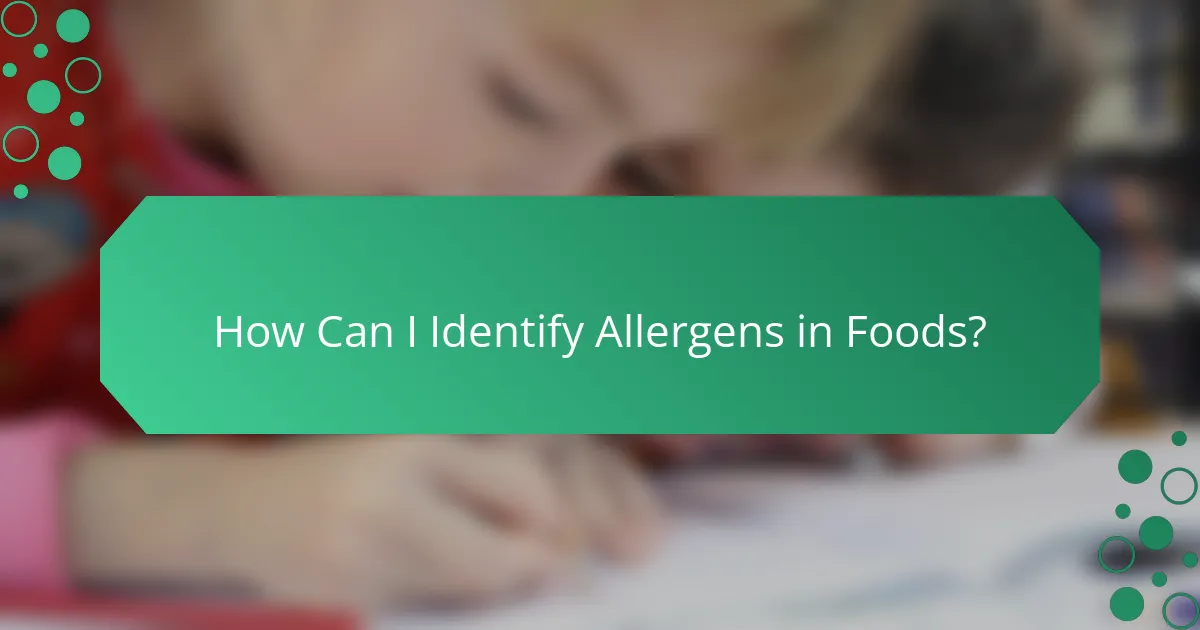
How Can I Identify Allergens in Foods?
Identifying allergens in foods is crucial for creating safe meal plans for kids with allergies. This involves understanding food labels, recognizing common sources of allergens, and consulting with healthcare professionals.
Reading Food Labels
Reading food labels is essential for identifying allergens. Look for allergen statements, which often highlight common allergens like peanuts, tree nuts, dairy, eggs, soy, wheat, fish, and shellfish. Ingredients are typically listed in descending order by weight, so pay attention to the first few items.
Be aware of terms that may indicate the presence of allergens, such as “may contain” or “processed in a facility that handles.” These warnings can help you avoid cross-contamination. Familiarize yourself with local regulations regarding labeling, as they can vary by country.
Common Allergen Sources
Common allergen sources include various foods that are frequently associated with allergic reactions. For example, dairy products like milk and cheese, nuts such as almonds and walnuts, and grains like wheat are prevalent allergens.
Fruits and vegetables can also cause allergies, though they are less common. Always consider hidden sources of allergens in processed foods, sauces, and baked goods, as these may contain unexpected ingredients.
Consulting with Allergists
Consulting with allergists is a critical step in managing food allergies. They can provide specific guidance on identifying allergens and may recommend allergy testing to pinpoint exact sensitivities.
Allergists can also help develop an emergency action plan, which is vital for ensuring safety in case of accidental exposure. Regular follow-ups can help monitor the child’s allergies and adjust dietary plans as needed.
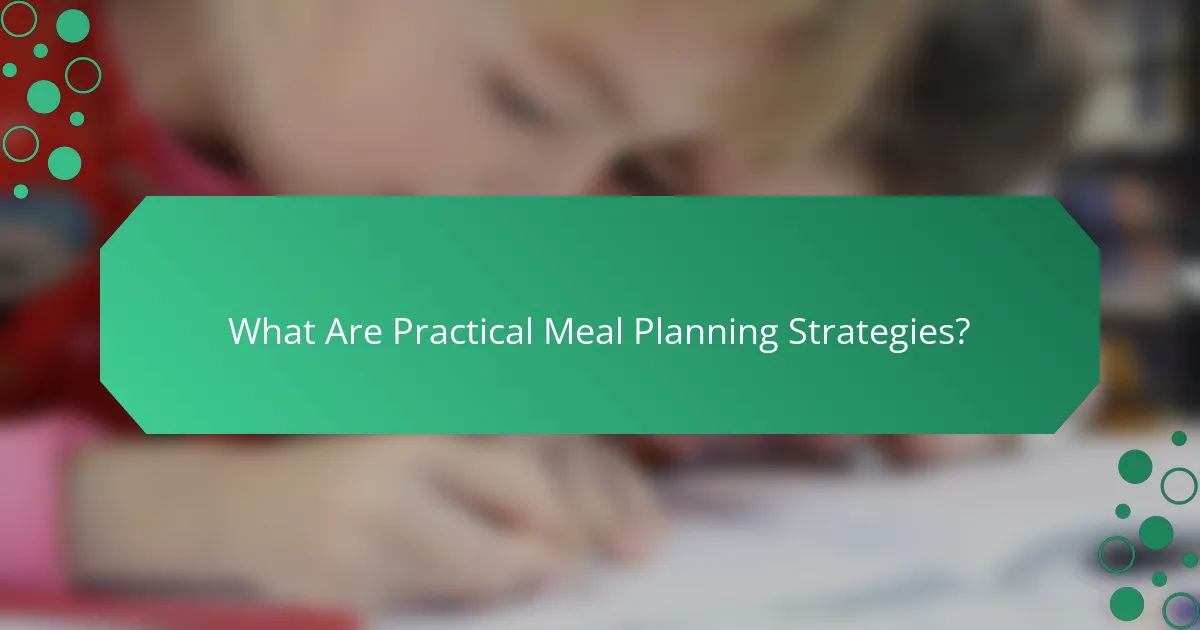
What Are Practical Meal Planning Strategies?
Practical meal planning strategies help create balanced meals for kids with allergies by ensuring variety, nutrition, and safety. These strategies focus on preparation methods and involving children in the process to make healthy eating enjoyable and manageable.
Batch Cooking
Batch cooking involves preparing large quantities of food at once, which can save time and ensure that meals are ready when needed. This method is particularly useful for families managing allergies, as it allows for the creation of safe, allergen-free meals in advance.
Consider cooking staples like grains, proteins, and vegetables in bulk. For instance, you might prepare a large pot of quinoa, roast several trays of vegetables, and cook chicken or beans all in one session. Store these in the fridge or freezer for easy access throughout the week.
Using Meal Prep Containers
Using meal prep containers can help organize and portion out meals effectively, making it easier to manage dietary restrictions. Choose containers that are BPA-free and suitable for freezing, microwaving, and dishwashing.
Label each container with the meal name and date to keep track of freshness. Consider using a color-coded system to differentiate between allergen-free meals and those that contain allergens, ensuring safety for all family members.
Involving Kids in Planning
Involving kids in meal planning can make them more excited about their food and help them understand their dietary needs. Allow them to choose from a selection of safe ingredients, which can empower them and encourage healthy eating habits.
Set aside time each week to discuss meal options and let them help with simple tasks like washing vegetables or assembling their lunches. This not only teaches them about nutrition but also fosters a sense of responsibility and creativity in the kitchen.

How Do I Create a Weekly Meal Plan?
To create a weekly meal plan for kids with allergies, start by identifying safe foods and ensuring a balance of nutrients. Focus on incorporating a variety of food groups while avoiding allergens to support healthy growth and development.
Template for Meal Planning
A meal planning template can help organize meals for the week. Begin by listing all meals for each day, including breakfast, lunch, dinner, and snacks. Use a grid format to visualize the week, making it easy to see what ingredients are needed and to ensure variety.
Consider categorizing meals by food groups such as proteins, grains, fruits, vegetables, and dairy alternatives. This approach ensures that each meal is balanced and meets dietary requirements.
Sample Weekly Menu
A sample weekly menu might include options like oatmeal with fruit for breakfast, a turkey and avocado wrap for lunch, and grilled chicken with steamed broccoli for dinner. Snacks could consist of carrot sticks with hummus or rice cakes with sunflower seed butter.
For a balanced week, aim to rotate different proteins and vegetables. For instance, use beans on one day, fish on another, and lean meats throughout the week. This variety helps prevent monotony and ensures a broader range of nutrients.
Adjusting for Nutritional Needs
Adjust the meal plan based on individual nutritional needs, which may vary due to age, activity level, and specific allergies. Consult with a healthcare provider or nutritionist to tailor the plan effectively.
For instance, if a child requires more protein, incorporate additional servings of legumes or safe meat alternatives. Always check labels for allergens and consider fortified options for vitamins and minerals if dietary restrictions limit choices.
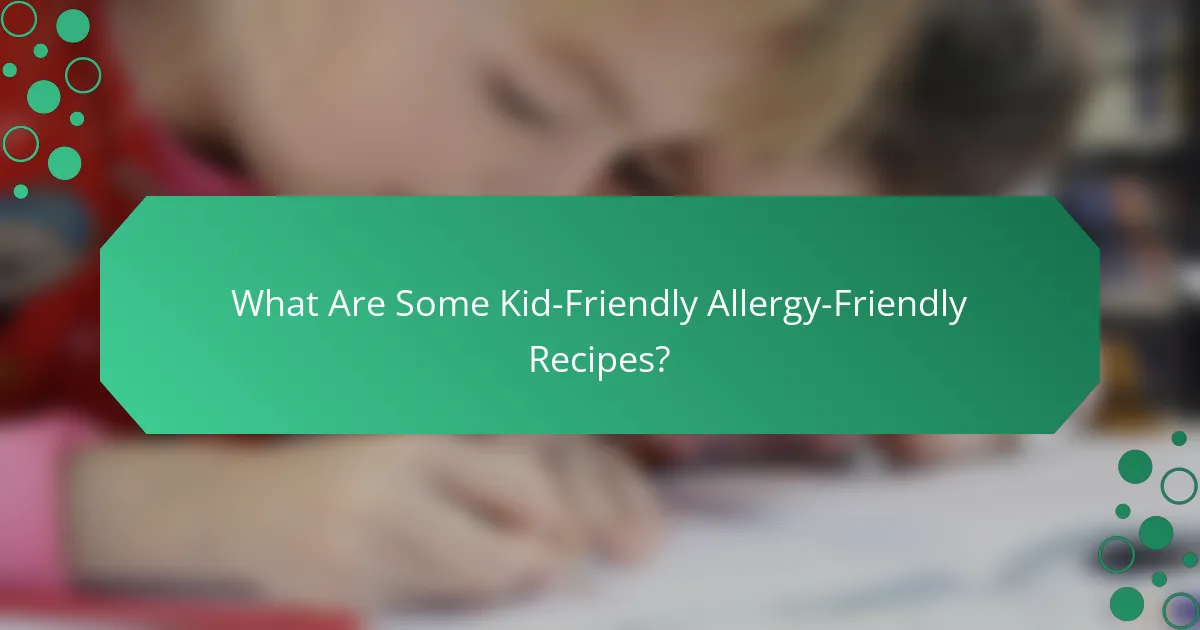
What Are Some Kid-Friendly Allergy-Friendly Recipes?
Kid-friendly allergy-friendly recipes focus on using safe ingredients that cater to common allergies while still appealing to children’s tastes. These recipes often substitute allergens with alternatives, ensuring that meals are nutritious and enjoyable.
Breakfast Ideas
Start the day with allergy-friendly breakfast options like oatmeal made with almond milk or coconut yogurt topped with fresh fruit. Smoothies using spinach, banana, and a dairy-free milk can provide essential nutrients while being tasty.
Consider making pancakes with gluten-free flour and a mashed banana for sweetness. Serve with pure maple syrup or a fruit compote for added flavor without allergens.
Lunch Options
For lunch, try a quinoa salad mixed with diced vegetables and a simple olive oil dressing. Quinoa is a great gluten-free grain that is high in protein and fiber, making it filling and nutritious.
Wraps using lettuce leaves filled with turkey or hummus and sliced veggies offer a fun, hands-on meal. Pair with fruit slices or allergy-friendly crackers for a complete lunch.
Dinner Recipes
Dinner can include stir-fried chicken or tofu with a variety of vegetables served over brown rice. Use gluten-free soy sauce or tamari to keep it allergy-friendly while maintaining flavor.
Another option is baked salmon with a side of sweet potato and steamed broccoli, providing a balanced meal rich in omega-3 fatty acids and vitamins. Always check labels for hidden allergens in sauces and seasonings.
